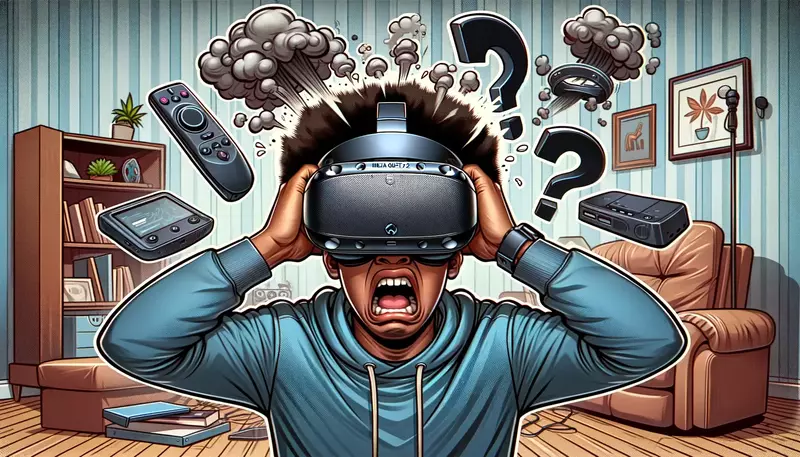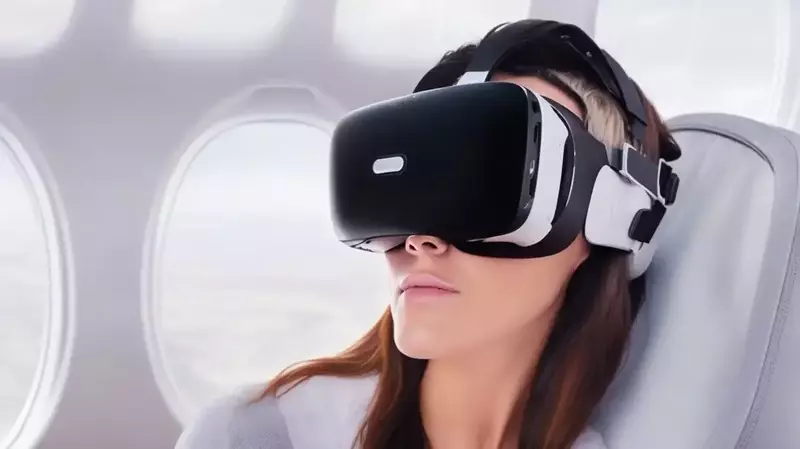This site contains affiliate links to products, and we may receive a commission for purchases made through these links.
Does virtual reality make you dizzy? As immersive and captivating as VR experiences can be, some individuals may find themselves grappling with dizziness or motion sickness while navigating these digital realms.
In this blog post, we’ll delve into the nuances of virtual reality to explore how it affects our sensory processing and learn ways to manage potential dizziness or motion sickness.

Does Virtual Reality Make You Dizzy?
Yes, virtual reality can make some people feel dizzy due to the immersive nature of the experience and the rapid movements that occur when navigating through virtual environments.
This dizziness is often a result of virtual reality sickness, which shares similarities with motion sickness experienced in real life.
Motion Sickness in VR
The disconnect between visual and physical sensations may cause queasiness, when your eyes perceive motion but your body does not.
In virtual reality, this disconnection can happen because you’re visually experiencing movement while physically remaining stationary. This sensory mismatch confuses your brain and may lead to feelings of nausea or dizziness.
Visual Strain and Disorientation
Besides motion sickness, visual strain from focusing on small objects for extended periods within VR environments can also contribute to dizziness. Additionally, unfamiliar surroundings or sudden changes in perspective might cause temporary disorientation, further exacerbating feelings of unsteadiness.
Tips for Reducing Dizziness:
- Take breaks: Give yourself time to adjust by taking regular breaks from using your VR headset every 20-30 minutes.
- Avoid rapid movements: Move slowly within the virtual environment to minimize any potential sensory mismatches that could trigger dizziness.
- Familiarize yourself with controls: Before diving into an intense gaming session or exploration adventure, take some time to familiarize yourself with the controls and settings available on your device so you know how best to navigate without causing discomfort.
- Create a comfortable play area: Ensure you have enough space to move around without bumping into objects, and consider using a swivel chair or standing mat for added stability.
Individual Differences in Susceptibility to VR Dizziness
Not everyone will experience dizziness while using virtual reality. People’s susceptibility varies due to factors such as age, previous exposure to similar experiences, and individual differences in sensory processing. Despite the varying susceptibility to dizziness while using virtual reality, it is still necessary to be mindful of potential risks and take appropriate precautions.
Finding the Right Balance:
To enjoy virtual reality without experiencing dizziness or discomfort, it is crucial to find a balance between immersion and comfort. This might involve experimenting with different games or experiences that offer varying levels of intensity until you discover what works best for you.
- Start with low-intensity experiences: Begin by exploring more passive environments like art galleries or nature scenes before moving on to action-packed games.
- Select appropriate content: Choose games designed specifically for VR platforms rather than those adapted from traditional gaming systems – these are often better optimized for comfortable play within virtual spaces.
- Incorporate breaks into gameplay: If possible, select titles that allow for natural pauses so you can rest your eyes and regain your bearings when needed.
Remember, taking these steps can help reduce the likelihood of experiencing dizziness while enjoying all that virtual reality has to offer.
Key Takeaway:
Virtual reality can make some people feel dizzy due to virtual reality sickness, which is similar to motion sickness. This disconnection happens because you’re visually experiencing movement while physically remaining stationary. To reduce dizziness, take breaks, move slowly within the virtual environment and familiarize yourself with controls before diving into an intense gaming session or exploration adventure.
What Causes Dizziness in Virtual Reality?
Dizziness in virtual reality is no joke. It can make you feel like you’re on a rollercoaster without the fun. So, what causes it? Let’s dive in.
Motion Sickness
One of the main culprits of VR dizziness is motion sickness. Your brain gets mixed signals from your eyes and inner ear, leading to nausea and dizziness. It’s like your body is saying “stop the ride, I want to get off.”
Tips to Reduce Motion Sickness:
- Choose games with smooth locomotion or teleportation options.
- Avoid sudden head movements during gameplay.
- Maximize your FOV settings if you can, gradually boosting it up as you go.
- Take it slow and steady. Gradually increase your VR exposure over time.
Disorientation
By gradually increasing your VR exposure over time, you may find yourself in unfamiliar worlds where balance issues and difficulty navigating can lead to disorientation. Without familiar reference points, you may experience balance issues and difficulty navigating.
Tips for Reducing Disorientation:
- Start with simple VR experiences to build familiarity.
- Use in-game navigation aids or markers when available.
- Maintain a point of reference within the virtual environment, like a fixed object or landmark.
Eye Strain
Staring at digital displays for lengthy periods can cause vision fatigue, resulting in discomfort such as headaches, fuzzy sight, and disorientation. Not exactly a recipe for fun.
Tips for Reducing Eye Strain:
- Adjust your VR headset’s interpupillary distance (IPD) settings for optimal comfort.
- Blink frequently during gameplay to keep your eyes moist.
- Follow the “20-20-20 rule”: every twenty minutes, look at something twenty feet away for twenty seconds.
Take measures to reduce the likelihood of VR sickness and be able to fully experience all that virtual reality has to give, without feeling like you’re in a spinning ride. Happy gaming.
Key Takeaway:
Virtual reality can cause dizziness due to motion sickness, disorientation, and eye strain. To reduce the risk of VR-induced nausea, choose games with smooth locomotion or teleportation options, avoid sudden head movements during gameplay, and gradually increase your exposure over time. Additionally, reducing disorientation involves starting with simple experiences and maintaining a point of reference within the virtual environment while reducing eye strain requires adjusting your headset’s settings for optimal comfort and following the “20-20-20 rule.”
How to Avoid Dizziness in Virtual Reality
Feeling dizzy while using virtual reality can be a buzzkill, but fear not. Taking pauses, moving gradually through digital realms and adjusting your VR headset settings can help you have an immersive experience without feeling off-balance or sick. For a more pleasant virtual reality experience, try taking pauses in-between sessions, move slowly through the digital world and adjust your headset settings to reduce any disorientation or nausea.
Take Frequent Breaks
One of the most effective ways to avoid dizziness in virtual reality is by taking regular breaks from gameplay. It is advised that you take a break of 30 minutes or less between VR sessions to give your body and mind time to readjust, along with engaging in activities such as walking around or drinking water which can help reduce dizziness and eye strain. During these breaks, remove your headset and engage in activities that help reorient yourself like walking around or drinking water. This will not only reduce feelings of dizziness but also help prevent eye strain caused by prolonged use of VR headsets.
Move Slowly Through Virtual Environments
Rapid movements within virtual environments can contribute significantly to motion sickness and dizziness experienced during VR sessions. To combat this issue, try navigating through the environment at a slower pace than usual; this allows your brain more time to process what it sees on screen as well as giving it less reason for confusion between actual physical movement versus perceived movement within the game. Motion sickness in VR often occurs when there’s a mismatch between what our eyes see and how our bodies feel – so reducing rapid movements should help alleviate symptoms.
Adjust Your Headset Settings
To ensure maximum comfort during gameplay and minimize potential dizziness issues related specifically with hardware usage itself (such as improper fit), make sure all aspects pertaining to your headset are correctly adjusted before beginning any session. This includes:
- Ensuring the headset is properly fitted and comfortable on your head
- Adjusting interpupillary distance (IPD) settings, which control the distance between lenses for optimal focus and reduced eye strain
- Calibrating height and room-scale tracking so that virtual objects appear at accurate distances in relation to real-world surroundings.
Taking time initially setting up these aspects will pay off dividends later when it comes to preventing dizziness during extended VR sessions.
Select Comfortable Games or Experiences
Content selection can have a major bearing on how probable it is to feel nauseous when utilizing virtual reality. Some games or experiences may be more prone to causing motion sickness due to their fast-paced nature, intense graphics/animations, or frequent changes in camera angles/positions within the game world itself. When selecting new titles to explore with your VR system – especially if you’re prone to feeling dizzy easily – consider looking specifically for those designed with comfort in mind; many developers now include “comfort ratings” alongside descriptions to help users make informed decisions about what they’re downloading and playing.
Incorporate Natural Movement Controls
Last but not least, try incorporating natural movement controls into gameplay whenever possible. Using physical movements like walking-in-place instead of joystick/thumbstick navigation helps create a stronger connection between your body’s actual position in space and your perceived location within the environment – reducing the likelihood of experiencing disorientation and nausea as a result of mismatched sensory input from your eyes and inner ear balance mechanisms. Experiment with different control schemes to find the one that works best for your personal preferences and individual tolerance levels when it comes to avoiding dizziness in virtual reality.
Key Takeaway:
To avoid dizziness in virtual reality, take frequent breaks, move slowly through virtual environments, adjust your VR headset settings and select comfortable games or experiences. Incorporating natural movement controls can also help reduce the likelihood of experiencing disorientation and nausea. Taking these steps will allow you to enjoy an immersive experience without feeling disoriented or nauseous.
FAQs in Relation to Does Virtual Reality Make You Dizzy?
Does Virtual Reality Make You Dizzy?
Yes, VR can cause dizziness due to factors like motion sickness, eye strain, and improper headset calibration, but not everyone experiences it.
Can Virtual Reality Trigger Vertigo?
VR has the potential to trigger vertigo in susceptible individuals due to the disconnect between visual input and physical movement.
Why Do Some People Get Dizzy in VR?
Dizziness in VR is often caused by a mismatch between what the user sees on screen and their actual body movements, leading to motion sickness or cybersickness.
How Many People Get Dizzy from VR?
The percentage of people who experience dizziness from VR varies widely, with around 40% of participants reporting symptoms of cybersickness during a 15-minute session.
Final Thoughts
Virtual Reality and Dizziness:
Virtual reality can make you feel dizzy, but don’t worry – there are ways to prevent it.
One way to avoid dizziness is to take breaks while using VR.
Another way is to adjust the settings to make the experience more comfortable.
Don’t let the fear of dizziness stop you from trying virtual reality – most people can enjoy it without any negative effects.
So go ahead and explore new worlds, just remember to take it easy at first!

Espen
Espen is the Director of PursuitMeta and has written extensively about Virtual Reality and VR Headsets for years. He is a consumer product expert and has personally tested VR Headsets for the last decade.




Leave a Reply